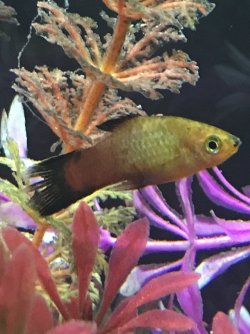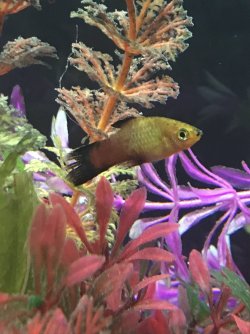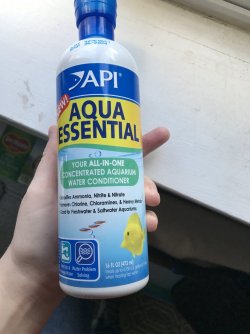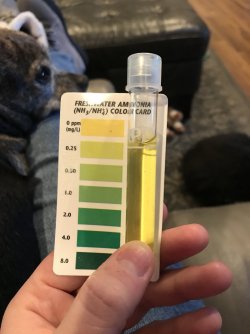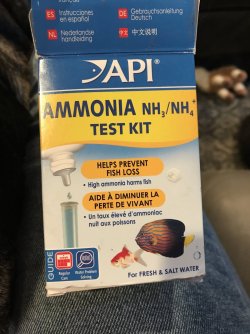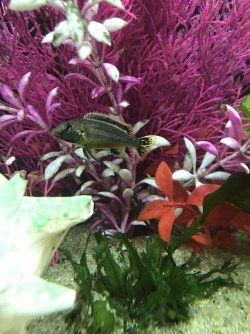You are using an out of date browser. It may not display this or other websites correctly.
You should upgrade or use an alternative browser.
You should upgrade or use an alternative browser.
Clamped fins and shredding tail treatments
- Thread starter BBfishes
- Start date
April FOTM Photo Contest Starts Now!

🏆 Click to enter! 🏆
What are your water parameters?
BBfishes
New Member
The nitrates were low a few days ago when I tested and did a water change. Now they’re spiking again.
Is your tank cycled? Also, you def need a test kit that tests ammonia asapView attachment 152677View attachment 152678
The nitrates were low a few days ago when I tested and did a water change. Now they’re spiking again.
BBfishes
New Member
Yes it WAS CYCLED. but did too large of a water Change a week or so ago and I think it’s destabilized the tank. Been having problems sense. I did a max change of 50% because I had let the tank go without a change and over fed. So nitrates got high. So did the 50% change. But as I was adding new water it pushed a ton of debris from over feeding a few days earlier that I missed with the section hose so I probably did a 55% change. Then tested again after almost a week and started feeding less and the nitrates were high again. So did a 30% change a few days ago. Now they’re high again. I’m not sure what to do next. Started using this new formula when I changed it a few days ago. Just added another 24 hour dose as directed. What should I do now?
Attachments
BBfishes
New Member
Here’s the ammonia testingIs your tank cycled? Also, you def need a test kit that tests ammonia asap
Attachments
Given the data in previous posts, and the fish appearance, I would first consider this to be a water issue.
The GH and pH are too low for livebearers; these fish must have moderately hard water as they need the calcium (primarily) for their physiological functions to properly occur. The GH appears to be in the 60 ppm range (= 3 or 4 dH) which is too soft. The pH looks like it may be below 7, which is acidic, and it should be above 7 for most livebearers. When kept in soft and slightly acidic water, compressed fins, shimmying, fin degeneration are common. There is no treatment other than providing harder water. That is easier said than done, but I don't know what other fish are present, and if they are soft water species, they may have issues with hardish water.
Second water issue is the nitrates. They seem to be around 20 ppm ? This is as high as you ever want nitrate, but if you can get it lower, the fish will benefit long-term. As close to zero as possible. Now, when you say they spike a lot, it suggests the tap water (used for water changes) is not likely the source of nitrate, so this is occurring solely within the aquarium. Is this correct? Test the tap water on its own for nitrate to be certain.
Nitrates that occur within the aquarium can be controlled by a number of things. Not overstocking, not overfeeding, regular substantial water changes, keeping the filter well cleaned, vacuuming the substrate (open areas) at each W/C, and live plants especially fast growing (floating plants are ideal for this). What is the normal low nitrate readng, and what is the highest?
Edit. As I was typing, the last post with ammonia showing 0 appeared, and this info further leads me to think it is the GH/pH primarily, and the nitrates not helping. All of these slowly weaken the fish so it has more and more difficulty maintaining its basic internal life essential functions.
The GH and pH are too low for livebearers; these fish must have moderately hard water as they need the calcium (primarily) for their physiological functions to properly occur. The GH appears to be in the 60 ppm range (= 3 or 4 dH) which is too soft. The pH looks like it may be below 7, which is acidic, and it should be above 7 for most livebearers. When kept in soft and slightly acidic water, compressed fins, shimmying, fin degeneration are common. There is no treatment other than providing harder water. That is easier said than done, but I don't know what other fish are present, and if they are soft water species, they may have issues with hardish water.
Second water issue is the nitrates. They seem to be around 20 ppm ? This is as high as you ever want nitrate, but if you can get it lower, the fish will benefit long-term. As close to zero as possible. Now, when you say they spike a lot, it suggests the tap water (used for water changes) is not likely the source of nitrate, so this is occurring solely within the aquarium. Is this correct? Test the tap water on its own for nitrate to be certain.
Nitrates that occur within the aquarium can be controlled by a number of things. Not overstocking, not overfeeding, regular substantial water changes, keeping the filter well cleaned, vacuuming the substrate (open areas) at each W/C, and live plants especially fast growing (floating plants are ideal for this). What is the normal low nitrate readng, and what is the highest?
Edit. As I was typing, the last post with ammonia showing 0 appeared, and this info further leads me to think it is the GH/pH primarily, and the nitrates not helping. All of these slowly weaken the fish so it has more and more difficulty maintaining its basic internal life essential functions.
BBfishes
New Member
Thank you so much. I have 4 platy. two angels.one killifish. 4 coradoras. And one yo-yo loach. And a pleco. It’s a 45 gallon tank.Given the data in previous posts, and the fish appearance, I would first consider this to be a water issue.
The GH and pH are too low for livebearers; these fish must have moderately hard water as they need the calcium (primarily) for their physiological functions to properly occur. The GH appears to be in the 60 ppm range (= 3 or 4 dH) which is too soft. The pH looks like it may be below 7, which is acidic, and it should be above 7 for most livebearers. When kept in soft and slightly acidic water, compressed fins, shimmying, fin degeneration are common. There is no treatment other than providing harder water. That is easier said than done, but I don't know what other fish are present, and if they are soft water species, they may have issues with hardish water.
Second water issue is the nitrates. They seem to be around 20 ppm ? This is as high as you ever want nitrate, but if you can get it lower, the fish will benefit long-term. As close to zero as possible. Now, when you say they spike a lot, it suggests the tap water (used for water changes) is not likely the source of nitrate, so this is occurring solely within the aquarium. Is this correct? Test the tap water on its own for nitrate to be certain.
Nitrates that occur within the aquarium can be controlled by a number of things. Not overstocking, not overfeeding, regular substantial water changes, keeping the filter well cleaned, vacuuming the substrate (open areas) at each W/C, and live plants especially fast growing (floating plants are ideal for this). What is the normal low nitrate readng, and what is the highest?
Edit. As I was typing, the last post with ammonia showing 0 appeared, and this info further leads me to think it is the GH/pH primarily, and the nitrates not helping. All of these slowly weaken the fish so it has more and more difficulty maintaining its basic internal life essential functions.
Thank you so much. I have 4 platy. two angels.one killifish. 4 coradoras. And one yo-yo loach. And a pleco. It’s a 45 gallon tank.
I'm afraid this now raises some other pending issues. But first, back to the GH...these fish (except the platies) are basically soft water fish, so your water is good for these. The platies are the problem.
Have you observed any physical aggression from the angelfish or the loach toward each other, or toward the platies? You need to sit motionless in front of the tank to really see what may be occurring.
The loach needs a group of five (or more), as this is a very social fish and without others of its own species it will b stressed and that means trouble down the road if not already.
How long have you had the platy?
Have you added anything to the tank in the 2 weeks before this started?
The tail could be bites from another fish.
The clamped fins and curved body shape look more like the start of an external protozoan infection. However, poor water quality can also cause it.
The ammonia is 0ppm so that is good.
Not sure what the nitrite is, the colour seems off to me and doesn't match the colour chart.
Nitrates are not causing this.
If you have nitrites, they will be adding to the nitrates and giving you a false nitrate reading. This is because nitrate test kits read nitrite as nitrate. So if you have a nitrite reading, that could explain why the nitrates are suddenly spiking.
--------------------
WHAT TO DO NOW?
Wipe the inside of the glass down with a clean fish sponge. This removes the biofilm on the glass and the biofilm will contain lots of harmful bacteria, fungus, protozoans and various other microscopic life forms.
Do a 75% water change and gravel clean the substrate every day for a week. The water changes and gravel cleaning will reduce the number of disease organisms in the water and provide a cleaner environment for the fish to recover in. It also removes a lot of the gunk and this means any medication can work on treating the fish instead of being wasted killing the pathogens in the gunk.
Make sure any new water is free of chlorine/ chloramine before it is added to the tank.
Clean the filter if it hasn't been done in the last 2 weeks. However, if the filter is less than 6 weeks old, do not clean it. Wash the filter materials/ media in a bucket of tank water and re-use them. Tip the bucket of dirty water on the garden/ lawn. Cleaning the filter means less gunk and cleaner water with fewer pathogens.
Increase surface turbulence/ aeration to maximise the dissolved oxygen in the water.
Add some salt, (see directions below).
If there's no improvement after a week with daily water changes and salt, or it gets worse during that time, post more pictures.
--------------------
SALT
You can add rock salt (often sold as aquarium salt) or swimming pool salt to the aquarium at the dose rate of 1 heaped tablespoon per 20 litres of water. If there is no improvement after 48 hours you can double that dose rate so there is 2 heaped tablespoons of salt per 20 litres.
Keep the salt level like this for at least 2 weeks but no longer than 4 weeks otherwise kidney damage can occur. Kidney damage is more likely to occur in fish from soft water (tetras, Corydoras, angelfish, Bettas & gouramis, loaches) that are exposed to high levels of salt for an extended period of time, and is not an issue with livebearers, rainbowfish or other salt tolerant species.
The salt will not affect the beneficial filter bacteria, fish, plants, shrimp or snails.
After you use salt and the fish have recovered, you do a 10% water change each day for a week using only fresh water that has been dechlorinated. Then do a 20% water change each day for a week. Then you can do bigger water changes after that. This dilutes the salt out of the tank slowly so it doesn't harm the fish.
If you do water changes while using salt, you need to treat the new water with salt before adding it to the tank. This will keep the salt level stable in the tank and minimise stress on the fish.
When you first add salt, add the salt to a small bucket of tank water and dissolve the salt. Then slowly pour the salt water into the tank near the filter outlet. Add the salt over a couple of minutes.
Have you added anything to the tank in the 2 weeks before this started?
The tail could be bites from another fish.
The clamped fins and curved body shape look more like the start of an external protozoan infection. However, poor water quality can also cause it.
The ammonia is 0ppm so that is good.
Not sure what the nitrite is, the colour seems off to me and doesn't match the colour chart.
Nitrates are not causing this.
If you have nitrites, they will be adding to the nitrates and giving you a false nitrate reading. This is because nitrate test kits read nitrite as nitrate. So if you have a nitrite reading, that could explain why the nitrates are suddenly spiking.
--------------------
WHAT TO DO NOW?
Wipe the inside of the glass down with a clean fish sponge. This removes the biofilm on the glass and the biofilm will contain lots of harmful bacteria, fungus, protozoans and various other microscopic life forms.
Do a 75% water change and gravel clean the substrate every day for a week. The water changes and gravel cleaning will reduce the number of disease organisms in the water and provide a cleaner environment for the fish to recover in. It also removes a lot of the gunk and this means any medication can work on treating the fish instead of being wasted killing the pathogens in the gunk.
Make sure any new water is free of chlorine/ chloramine before it is added to the tank.
Clean the filter if it hasn't been done in the last 2 weeks. However, if the filter is less than 6 weeks old, do not clean it. Wash the filter materials/ media in a bucket of tank water and re-use them. Tip the bucket of dirty water on the garden/ lawn. Cleaning the filter means less gunk and cleaner water with fewer pathogens.
Increase surface turbulence/ aeration to maximise the dissolved oxygen in the water.
Add some salt, (see directions below).
If there's no improvement after a week with daily water changes and salt, or it gets worse during that time, post more pictures.
--------------------
SALT
You can add rock salt (often sold as aquarium salt) or swimming pool salt to the aquarium at the dose rate of 1 heaped tablespoon per 20 litres of water. If there is no improvement after 48 hours you can double that dose rate so there is 2 heaped tablespoons of salt per 20 litres.
Keep the salt level like this for at least 2 weeks but no longer than 4 weeks otherwise kidney damage can occur. Kidney damage is more likely to occur in fish from soft water (tetras, Corydoras, angelfish, Bettas & gouramis, loaches) that are exposed to high levels of salt for an extended period of time, and is not an issue with livebearers, rainbowfish or other salt tolerant species.
The salt will not affect the beneficial filter bacteria, fish, plants, shrimp or snails.
After you use salt and the fish have recovered, you do a 10% water change each day for a week using only fresh water that has been dechlorinated. Then do a 20% water change each day for a week. Then you can do bigger water changes after that. This dilutes the salt out of the tank slowly so it doesn't harm the fish.
If you do water changes while using salt, you need to treat the new water with salt before adding it to the tank. This will keep the salt level stable in the tank and minimise stress on the fish.
When you first add salt, add the salt to a small bucket of tank water and dissolve the salt. Then slowly pour the salt water into the tank near the filter outlet. Add the salt over a couple of minutes.
BBfishes
New Member
No one angel fish bullies the other. The loach minds it’s own business. And none of them have shown aggression to any of my plates. Oh and I forgot about two weeks ago I added my cichlids from my ten gallon aquarium into the 45 so I could get ember tetras. So far he seems to not be aggressive aside from one time getting in a fight with my angel fish and chasing occasionally anyone who comes near his nest which isn’t very often, but his color has changed since moving him. As soon as I did a treatment and got the nitrates down his color came back instantly. He’s usually has a yellow belly. I’ll attach his picture of him in his present stressed state below.I'm afraid this now raises some other pending issues. But first, back to the GH...these fish (except the platies) are basically soft water fish, so your water is good for these. The platies are the problem.
Have you observed any physical aggression from the angelfish or the loach toward each other, or toward the platies? You need to sit motionless in front of the tank to really see what may be occurring.
The loach needs a group of five (or more), as this is a very social fish and without others of its own species it will b stressed and that means trouble down the road if not already.
Attachments
The cichlid in the picture looks like a Melanochromis auratus and they are real nasty. They also require hard water with a high pH. Angelfish come from soft water with a low pH.
The M. auratus needs to be moved into its own tank asap because it will kill other fish when it matures.
The M. auratus needs to be moved into its own tank asap because it will kill other fish when it matures.
Latest Discussions
- Replies
- 0
- Views
- 1
- Replies
- 10
- Views
- 185
trending
-
-
-
-
-
F-1 Angel... a bit nervous... it'll be my 1st F-1 fish...
- Started by Magnum Man
- Replies: 17
Members online
Total: 558 (members: 10, guests: 548)

